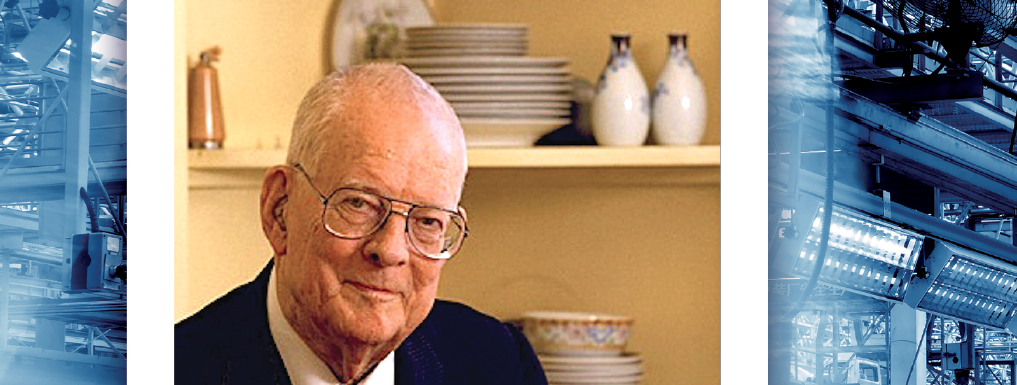This year marks the 25th anniversary of the passing of Dr. W. Edwards Deming, the world’s foremost quality and management guru. Deming had a remarkable impact on the lives of millions—more accurately, hundreds of millions—and is often named one of the most influential people of the 20th century. In Japan, he’s revered as a folk hero, and every high school student knows his legacy and principles. The highest honor a company can earn is “The Deming Prize,” Japan’s national quality award for industry.
Ironically, most people in the U.S. today hardly recall his name—if they ever knew it at all. In the post-World War II boondoggle of U.S. economic superiority, we believed our rabid success was due to superior management practices. In truth, the rest of the world’s industrial capacity lay somewhere between severely crippled and utterly destroyed. As terrible as the war was for America in terms of loss of life, not a single bomb fell on U.S. soil, leaving us as the only true economic powerhouse for the next quarter century. We could sell whatever we made anywhere in the world, no matter the quality—and we did. We believed we were geniuses. Deming was one of the few who saw through the charade early on.
Deming’s philosophy was shaped by his experience at Western Electric in 1925-26 during industrial researcher Elton Mayo’s famous Hawthorne Experiments on worker productivity, and by meeting physicist (and inventor of the statistical control chart) Walter A. Shewhart, who would became his mentor, teaching Deming how to apply statistics to measure and control process variation. That understanding of variation would became a key element of Deming’s philosophy.
During World War II, Deming served as a consultant to the Department of War, teaching statistical process control to thousands of engineers engaged in the Herculean task of supplying the essential weapons, ammunition, food, medicine, vehicles, fuel, etc., for more than 6 million soldiers serving overseas in Europe, North Africa, and the Pacific. The lessons Deming learned in those years coalesced into a system of management, leadership, and production principles that set the status quo back on its heels and did not endear him to practitioners of traditional management philosophy.
The Fountainhead
Deming first went to Japan in the late 1940s, called there for statistical analysis by the U.S. occupation authorities to consult on the Japanese census. But, over time, the Japanese saw that Deming could help them redevelop their devastated industrial base. In 1950, when the top 50 CEOs in Japan were invited by JUSE (Japanese Union of Scientists and Engineers) to learn Deming’s strategy on how to completely upend the world industrial order and emerge on top, all 50 participated. Every single one. That seminar launched the Japanese industrial juggernaut, most notably the Toyota Production System, which remains the epitome of process thinking that has inspired previously unimaginable improvements in quality and productivity. Efforts to engage American executives at similar meetings during the ’50s largely failed. As a result, U.S. industry got its clock cleaned during the ’70s and ’80s with the influx of intense foreign competition. It wasn’t until the ’90s that we began to wake up.
To their credit, U.S. domestic automakers have now, after giving the competition a decades-long head start, closed that gap and today provide excellent, competitive, high-performance products. But our stubbornness and refusal to learn cost us millions of jobs and billions in profit. There were many thought leaders involved in this process, including Feigenbaum, Goldratt, Ishikawa, Juran, Ohno, and Shingo, but the fountainhead was Dr. Deming.
Deming’s impact is hardly limited to automotive, but the monumental change in that industry is the easiest to document. If you were born after 1980, it’s almost impossible to appreciate how bad our vehicles were then compared with today. Yes, there were some fantastic designs in the ’50s and ’60s, but mechanically and structurally, vehicles were mostly horrific. In the 1970s and ’80s, they were both ugly and poorly built. You did your oil and filter changes every 3,000 miles or you were asking for trouble, including an extensive lube job. Brakes lasted 10,000 miles at best. Tires might run 20,000; exhaust, shocks, and struts maybe 30,000. After the second winter, anywhere north of Nashville, you had body and frame rust, often badly. Safety was abysmal, as automakers fought every improvement, and a car approaching 20 miles per gallon was an anemic six-banger. Any decent V-8 with power, and you were very lucky to get 15 miles per gallon, if you gently nursed the throttle.

No More Tune-Ups
Still skeptical? When was the last time you took your car in for a “tune-up”? How many of you just thought, “What’s that?” Back then, you were lucky to keep a car in tune for 10,000 miles, which required careful adjustment of points, plugs, timing, and carburetion. Almost everyone with any mechanical inclination had a timing light and knew how to adjust points and clean and gap the spark plugs. To hammer this point home, I just found some interesting statistics. The average car on the road in America 30 years ago was five years old with 60,000 miles. Today, the average vehicle is 11 years old with 165,000 miles. All the while, plant productivity has significantly risen.
Cars do cost 10 to 15 percent more than they did 30 years ago, in terms of average hours worked to purchase. Yet the total cost of ownership is considerably lower. And the old cars had crummy radios, manual locks, crank windows, lousy climate controls, cheap interiors, bad seats, and almost no safety features. You want 225 horsepower with 30 miles per gallon and low emissions? An engineer back then would have laughed in your face. Push-button start from your kitchen on a hot summer or cold winter day? They’d accuse you of smoking the curtains and channeling Buck Rogers. But I can do it anytime I want via the app on my smartphone. I can also lock, unlock, see how much fuel is in the tank, how many miles until my next oil change, and request emergency road service. Apples to apples, our cars today are much cheaper and much better than those built in the industrial heyday of the ’50s and ’60s.
There’s no arguing with those numbers from automotive. And similar improvements in product quality and productivity are also found in electronics, food processing, heavy equipment, agricultural equipment, aircraft manufacturing, and other industries. In fact, nearly every industry has experienced massive productivity gains since the ’50s—every industry, that is, except home building. Recently, many graphs and charts showing this gap have been featured in articles and presentations, most advocating the need to mechanize and componentize home building. There’s no question this needs to happen, but it’s been stop-and-go for 50 years and we haven’t yet passed the tipping point where we go that way wholesale. Is the industry thus doomed to stay mired in the doldrums?
I believe the answer is absolutely no, but, as Dr. Deming said, “Survival is optional.” There is tremendous inertia to just keep doing what we’ve been doing, only trying harder. After three decades in the industry, my TrueNorth colleagues and I have seen so much improvement in individual builders that we know what’s possible. Although the high-level success stories are rare, there are more than enough to prove it can be done. And there is no better place to start than by revisiting the teachings of Dr. Deming.
Quotable
Deming was the originator of a remarkable number of quotes to inspire and make us think. The insights from some of his sayings are immediately clear and smack you right between the eyes such as, “A bad system will beat a good person every time.” How many times have we all seen this? A good person, sincere, hardworking, wanting to do a solid job, just beaten down by bad process and systems.
But many of Deming’s quotes are more subtle. They start out simple, then grow on you, becoming more profound as time passes and you gain deeper experience. For example, he would stand in front of a workshop group of 300 or more, stare down the assemblage for a few moments in a pause so pregnant you were sure a birth was imminent, then ask, “What is the aim of the system?” He’d just let it sit there until folks squirmed in their chairs, before he’d bark “Think about it!” in his gravelly voice.
And so I’ll repeat the good Doctor’s words: Think about it! Last month I wrote the last in my series of four columns on the crippling, profit-robbing, pervasive issue of variance, usually expressed through the VPO, or variance purchase order. When we work with builders to improve this critical process, we first ask just that: “What is the aim of the system?” It’s surprising how few builders ever stop to ponder that question, and even fewer have a good answer. Try this exercise with your team: Challenge them by asking, “What is the aim—purpose, goal, and objectives—of our VPO system?” When they stop, as most will, at the level of “Specify the work required and price of a variance from standard production,” you have some work to do because that definition just scratches the surface.

All I Have to Offer You Is Profit
Deming was a visionary, to be sure, but he was also practical. It’s impossible to spend your youth in a tar-paper shack on a farm outside Powell, Wyo., as Deming did, trying to stay warm and hack a living out of the frozen tundra, without becoming really practical. He was also a realist and knew that to get most people onboard requires a show-me-the-money approach. I’ve watched over the years as home building managers and executives dismiss many Deming teachings as wishful thinking or some version of an industrial fantasyland. Yet the impact on so many other industries is undeniable. In comparison, home building has paled in productivity gains. Will we remain in denial or will we resolve to fix it?
In Deming’s 90th year, he led more than 30 four-day stand-up workshops. He didn’t need the money. Given the travel, hotels, and eating on the road, 100 booked days is about the limit for much younger consultants. Deming was just that driven. I have video shot around that time of a reporter interviewing him at the airport. Asked how he was feeling, having so much on his plate, Deming shook his head and replied, “Just frantic, that’s all.” He was keenly aware he didn’t have much time left and believed he had just begun with American management.
In our last monthly meeting with Dr. Deming and the Detroit Deming Study Group, a gathering in which I was the only participant from home building, he’d grown quite frail. He had two attendants, an oxygen bottle, and he drifted off to sleep a few times during the two-and-a-half-hour meeting. No one moved, though, and no one left early, avoiding any chance that the good Doc may perceive even the slightest disrespect. We knew we were in the presence of greatness, probably for the last time. Dr. Deming passed away just a few weeks later.
Back to the Master
Anyone who has followed this column for 20 years will recall many mentions of Deming’s name and applications of his quotes to issues in our business. I hope this is a good indication his teachings fit home building as well as they do myriad other industries. Builders are always looking for an edge—anything to be better than the next guy. So often it is sought through sales gimmickry, marketing campaigns, or price cuts. Each of those, however, is short-term and self-extinguishing.
What if you resolved for the new year that you are going back to the master? Go back and revisit Deming’s wisdom—or discover him for the first time. But be prepared for some hard work and an intense challenge to your current beliefs.
Next month we’ll explore, in depth, a collection of Deming teachings and make the link to our beloved but always-struggling business of home building. PB
For links to free PDFs of Scott’s articles about bridging the margin gap, solving the trade shortage, or tackling variance, email info@truen.com.













